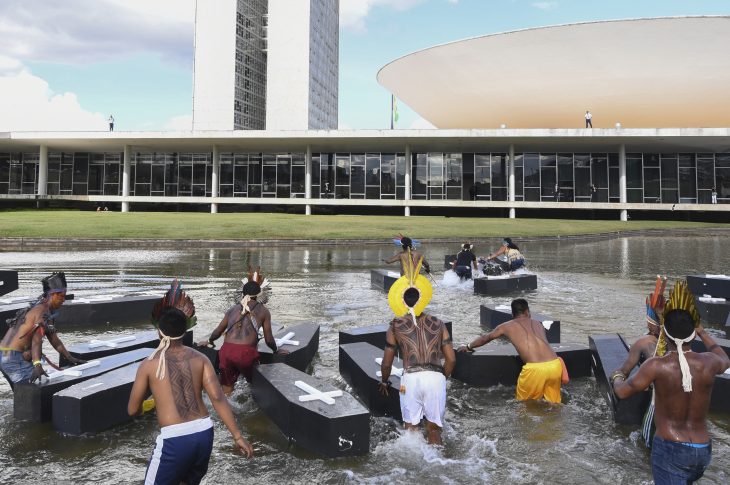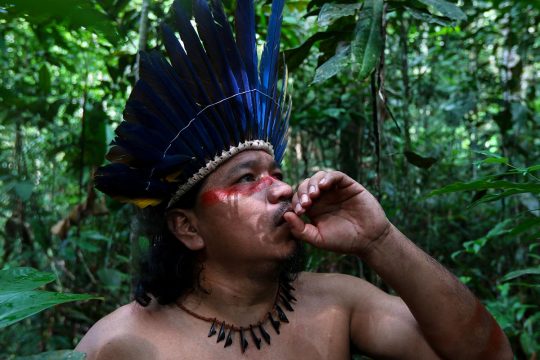In a historic decision regarding crimes against humanity committed by the military dictatorship (1964-1985) against the indigenous Kinja people (also known as Waimiri-Atroari), the Brazilian Federal Justice of the state of Amazonas put out restraining orders against the Federal Government and the National Indian Foundation (FUNAI), opening the way for an unprecedented judicial acknowledgement of the violence suffered by the Kinja Indigenous during that period.
In this first writ on 01.19.2018 the court obliged the Federal Government to present in the next 15 days all the documents concerning the military operations carried out between 1967 and 1977 in Amazonas and determined that FUNAI shall immediately protect the sacred sites still threatened by the invasion of Kinja’s land. Containing 1,500 pages of documentation, the judicial proceeding might be the first in history where a national court holds the Brazilian State accountable for genocide.
Amazon Forest
After the military coup in 1964, the government developed an official strategy for the occupation and exploitation of the North of Brazil, where the Amazon Forest and the ancestral land of many indigenous people are located. As part of the plan that longed for a “Great Brazil”, from 1968 to 1977 the federal government has built the road BR-174 connecting Manaus (Amazonas) to Boa Vista (Roraima), splitting the Kinja’s land and authorizing the use of force to discourage their historic resistance in having their sacred places occupied by outsiders.
According to the National Truth Commission and the Truth Committee of the State of Amazonas the construction of the BR-174 by the militaries claimed the lives of thousands of the Kinja, whose population was reduced from 3,000 individuals (in the 70s) to 332 individuals (in the 80s), as a result of comissive and omissive acts by the Army and the National Indian Foundation (Funai, in Portuguese initials). In addition, testimonies collected by the Federal Prosecutor’s Office (MPF, in Portuguese initials) reported that many corpses were buried in mass graves opened on the side of the road and that airstrikes were conducted over the Kinja’s villages, also reporting the use of chemical substances “similar to napalm”.
(“Airplanes, helicopters, bombs, machine guns, electric cables and weird diseases” - a Kinja’s drawing shows the attacks during the genocide in the '70s)
Torture
Other episodes of abuse committed by the dictatorship against indigenous groups in Brazil are known and some are being investigated. In 2012, for exemple, Marcelo Zelic, from Grupo Tortura Nunca Mais, have disclosed images of individuals of the group Krenak, from Minas Gerais, attending to a military parade as members of a Rural Indigenous Guard and being victims of a public demonstration of the use of torture instruments. On the parade a Krenak individual was tied to a Pau-de-Arara. The Krenak were also victims of cultural genocide trough military attacks, occupation of their land and confinement on public reformatories, for instance. Another group directly affected by the Brazilian dictatorship is the Suruí, from Pará, recognized in 2015 by the Amnesty Commission of the Ministry of Justice as victims of attacks conducted by the Army during the Araguaia Guerrilla. Finally, in 2000 the case of the Panará people, which was also affected by the construction of a new road in the North from Cuiabá to Santarém (Pará) during the dictatorship, the Federal Justice have condemned the State to repair the damages caused by the interethnic contacts, for spreading diseases between the Panará, and for the displacement of their people.
Following legal channels, the acknowledgment of the genocide and other gross human rights offenses would be especially remarkable considering the wide effects that a self-amnesty law (approved by the dictatorship in 1979) still represents to transitional justice in Brazil. The law is widely applied by criminal courts, raising obstacles to criminal investigations, convictions and frustrating all charges against offenders brought to Justice by the MPF’s prosecutors over the last decades. This legal understanding was validated by the Federal Supreme Court (STF, in portuguese initials) in 2010, just before the Inter-American Court of Human Rights declares that Brazil’s self-amnesty law was incompatible with the American Convention of Human Rights.
Although the criminal way remain blocked, making the State accountable for the Kinja’s genocide and other gross human rights violation would be an important non-criminal precedent for those who struggle against obstacles to accountability in cases of human rights violations where public policies have severely harmed social groups, especially political minorities like indigenous, afro-brazilians, slum residences etc. As said in MPF’s suit “the violation committed by the State have permanent effect on the Kinja’s people”, what can be observed in different situations across the country were people affected by inhuman policies and acts are not yet declared victims of the military dictatorship. But the findings in the Kinja’s case might be wider than the transitional justice’s achievements concerning the military period. In fact, it would be the first court decision ever to ensure accountability of the Brazilian State for genocide, country were genocide is a practice that travels across the centuries to the present. In 2006 the STF upheld the conviction of genocide against four miners who murdered 16 Yanomami Indians in 1993, what represented an important warning at the time to those individuals who continue to commit crimes against indigenous people in Brazil.
Sacred sites
The Amazonas Federal Court will meet again on the 02.14.2018 to listen to the Kinja Indigenous, when they will point their sacred sites out to be protected by Funai. Beyond the “exclusive accountability of the government that have set up a conscious and global program oriented for the genocide and ethnocide of that people” the MPF requests the creation of a Memory Site regarding the human rights violation against the indigenous people in Brazil, the collective reparation in the amount of R$ 50 millions (U$ 15.400.255,00), official apologies for all the losses suffered by the Waimiri-Atroari, among other measures.
The National Indian Foundation (FUNAI)
The National Indian Foundation (FUNAI) is the Brazilian official body that establishes and carries out policies relating to indigenous peoples. Created in 1967, the body succeeded the Indigenous Protection Service, created in 1910. FUNAI is responsible for protecting lands traditionally inhabited and used by these communities. FUNAI’s task is to ensure that indigenous rights are respected as established in the Brazilian Constitution (1988) and the controversial Indian Statute (1973), approved during the military dictatorship.






